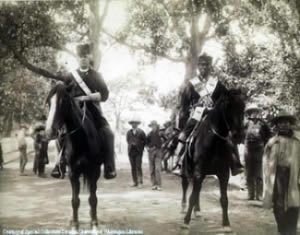
Lesson Twelve:
Indian Reservations, Resistance, and Changing Indian Policy since 1850
This view (left) shows Indian Agent Captain Thomas Priestly with Chief White Swan taken in front of the Agency House at Fort Simcoe in 1888 or 1889. Even though many Native Americans lived away from the reservations, many maintained their links to them, and to the military forts which were also a component of reservation policy. (Special Collections, University of Washington, Fort Simcoe files.)
c. 1850 1934 1953 1974 |
The U.S. government made reservations the centerpiece of Indian policy around 1850, and thereafter reserves became a major bone of contention between natives and non-natives in the Pacific Northwest. However, they did not define the lives of all Indians. Many natives lived off of reservations, for example. One estimate for 1900 is that more than half of all Puget Sound Indians lived away from reservations. Many of these natives were part of families that included non-Indians and children of mixed parentage, and most worked as laborers in the non-Indian economy. They were joined by Indians who migrated seasonally away from reservations, and also from as far away as British Columbia. As Alexandra Harmon's article "Lines in Sand" makes clear, the boundaries between "Indian" and "non-Indian," and between different native groups, were fluid and difficult to fix. Reservations could not bound all Northwest Indians any more than others kinds of borders and lines could. 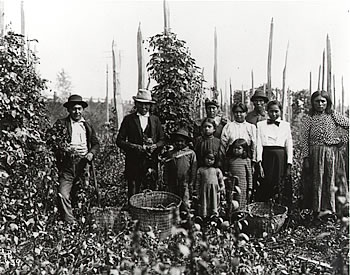
Nonetheless, reservations were places where Indians remained concentrated and where the federal government continued to exert its most concerted effort to transform natives into people who more resembled Anglo-Americans. Indian agents pressured natives on reservations to abandon the remnants of their cultures. Reservation doctors at Colville, for example, were instructed to discredit Indians' faith in traditional Indian medicine, including sweat houses. Indian agents outlawed certain types of dances as well as plural marriages. One means of converting natives was to supply subsidies that undermined traditional means of subsistence. Indians who became dependent on the government's provisions could be coerced by threats to withhold supplies. When the Nez Perce leader Joseph at the Colville reserve protested the sending of Indian children to boarding schools in 1901, for instance, he was denied his ration of beef. The boarding schools, of course, represented another point to pressure Indians to conform to white ways. Agents expected them to work efficiently because they had taken children away from the cultural influence of their parents. The schools compelled students to dress like non-Indians and speak English, and punished those who did not conform. Students who returned from boarding schools had generally not been fully assimilated, yet they often felt estranged from their tribe or band when they went home. In sum, there was considerable pressure placed on natives to adopt Anglo-American ways.
A Indian family working as hops pickers (above right). (Courtesy Special Collections Division, University of Washington. UW Negative #na6633.) Skokomish Indian School, 1892 (below).
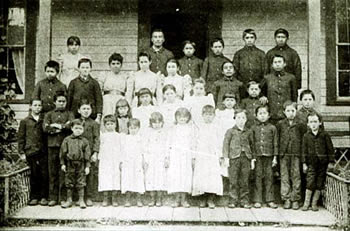
Yet Indians found numerous ways to resist complete assimilation and retain elements of their traditional cultures (although these cultures were themselves changing in myriad ways). One method was the practice of religion. In 1850 the Wanapum prophet Smohalla experienced his first visionary dream that encouraged all Indians to live according to their old customs and ways. This and other visions became the basis, during the later 19th century, for a prophetic religion among natives of the Northwest. Smohalla and his many followers believed that if natives adhered to old ways and resisted white ways, they could hasten the arrival of some sort of cataclysm that would remove non-Indians from the land and restore to the world the harmony supposed to exist before whites arrived. This vision, which resembled those of other Indians in North America, was the key to the new "dreamer" religion among many native peoples of the Northwest during the later 19th century, which took root on the Colville reservation and among other Indian groups. Instructed by their faith to follow traditional ways, the so-called Dreamers resisted pressures on them to acculturate to white ways.
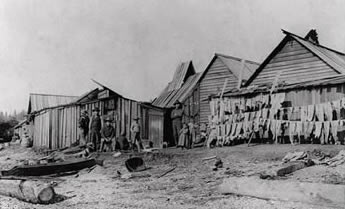
In this Suquamish settlement near Eagle Harbor (right) photographed at the turn of the twentieth century, western-style dress and housing are combined with the traditional method of drying fish. (Special Collections, University of Washington. Photo by Webster and Stevens, UW negative #NA700.)
Some Indian groups found other means to preserve aspects of their cultures. The Makah experience, in the far northwestern corner of Washington, illustrates another experience. The Makah reservation was created out of the tribe's traditional territory and offered access not only to land-based supplies but also to the salt-water resources that the Makahs had long exploited. Government-sponsored attempts to get the Makah to farm generally fizzled. Between the founding of the reservation in 1855 and the Great Depression of the 1930s, however, the Makah Indians continued the whaling, sealing, and fishing that had sustained them for centuries. These activities were not the same as they had been before; the Makah incorporated new technologies to succeed, participated in the emergent market economy, and learned how to speak English and otherwise get along with non-Indians in the worlds of labor and commerce. But while learning to adapt to non-Indian society, these Indians refused to assimilate. They kept traditional occupations alive, and also maintained a measure of prosperity—something most other Washington tribes could not claim. [See also "Subsistence and Survival: The Makah Indian Reservation, 1855-1933," Cary C. Collins, Pacific Northwest Quarterly] Many native peoples combined their traditional cultural practices with those introduced by Euro-Americans.
Another form of Indian resistance was litigation. Natives pressured the United States to live up to the terms of the treaties it had signed in the mid-19th century. Yakama Indians launched the first cases to uphold Indian fishing rights on the Columbia River in 1887 and 1905. These lawsuits, which were partially successful, were the first of a series spanning more than a century by which native groups protected their access to the fisheries of Washington and Oregon. However, federal courts allowed Oregon and Washington to regulate Indian fisheries, and both states placed substantial limitations on Indian fishing. Native groups kept the issues alive in the courts over the decades of the 20th century until the U.S. government finally decided to throw its weight behind the Indian position during the late 1960s and the 1970s. The Boldt decision of 1974, upheld by the U.S. Supreme Court in 1979 and further expanded with regard to shellfish during the 1990s, cemented the rights to fish that Indians had claimed based on treaties signed in the 19th century. Specifically, the Boldt decision guaranteed Indians the right to catch one-half of the commercial salmon harvest every year (even though Indians in western Washington amounted to no more than 2% of the total population). With the precipitous decline of runs of salmon, this decision put pressure on Indians and non-Indians to co-operate with one another to protect the remaining salmon fisheries of western Washington. By the time of the Boldt decision, U.S. Indian policy had undergone some crucial changes. The general effort to have Indians assimilate into non-Indian society remained in force until the 1920s and 1930s.
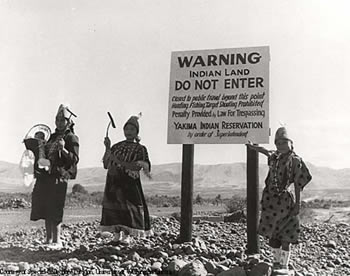 Yakima Reservation Boundary. The Yakima Indians were another tribe, along with the Colvilles, who protected their boundaries and rights, as this 1950s photograph shows. The original caption reads: "Barriers prevent all except Indians from much of the reservation and passes are required to enter." (Special Collections, University of Washington Libraries. Photo by J. W. Thompson, UW negative #NA761.)
Yakima Reservation Boundary. The Yakima Indians were another tribe, along with the Colvilles, who protected their boundaries and rights, as this 1950s photograph shows. The original caption reads: "Barriers prevent all except Indians from much of the reservation and passes are required to enter." (Special Collections, University of Washington Libraries. Photo by J. W. Thompson, UW negative #NA761.)
At that time, reformers led by John Collier determined that this policy was wrong. One reason that whites changed their minds about what was good for the Indians is that whites began to doubt the virtues of their own society. The growth of industry, inequality, and other social concerns prompted some whites both to criticize their own culture and to look at other cultures more favorably. Collier believed that whites had much to learn from Indians, and he dedicated himself to making federal policy less coercive and assimilationist. Franklin D. Roosevelt appointed Collier as superintendent of Indian affairs during the New Deal, and together FDR and Collier pushed the Indian Reorganization Act through Congress in 1934. This law was meant to encourage Indian tribes and bands across the country to preserve their traditional cultures. It also granted Indians greater say in the administration of reservations and tribal affairs. On the Colville reservation, the many different tribes took advantage of this opportunity to form a confederated government to assume greater control of reservation life. The decision led to a greater sense of commonality among the once diverse groups of Indians. However, as on other reservations, there remained many differences and disagreements between Indians.
Events after the 1930s affected reserves in many ways. Completion of Grand Coulee Dam on the Columbia River, for example, eliminated upstream runs of salmon on the Columbia, and destroyed the fishery at Kettle Falls. The Colville reserve received some of the first electricity generated by the Grand Coulee hydro plants, but this hardly made up for the loss of the salmon. The nation's mobilization for World War Two and the Cold War recruited many Indians away from reservations and into either the armed services or the numerous defense-related jobs in urban areas such as Seattle, Portland, and Spokane. Many Indians did not return once the war was over. Finally, in the midst of the Cold War and its pressure for social and cultural conformity, there was a temporary turning away from the ideas of John Collier and a return to assimilationist thinking. Congress in 1953 officially adopted a policy known as "termination," by which it aspired "to make the Indians...subject to the same laws and entitled to the same privileges and responsibilities as are applicable to other citizens..., to end their status as wards of the United States and to grant them all of the rights and prerogatives pertaining to American citizenship." Across the United States, only 3% of all Indians would be terminated, but among these were the Klamath Indians of southern Oregon and the 61 tribes and bands of western Oregon. (One faction of the Colville also filed for termination, but their effort was not completed.) These groups expected that termination would provide an overall economic benefit, as tribal resources would be sold and the proceeds distributed to members of the tribe, and as federal controls over community resources would be abandoned. The Klamath, for example, anticipating receiving $43,700 apiece, succeeded in being "terminated" in 1961. This produced a temporary bonanza, but over time the Klamaths went from prosperity to relative poverty. Western Oregon groups similarly experienced adversity from termination, and by the 1970s and 1980s were taking steps to reverse the process and restore their relationship with the federal government.
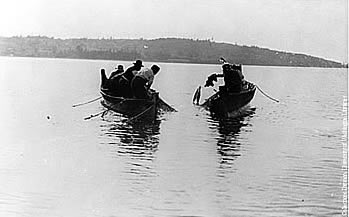
Reef net fishing, as shown in this 1930s view, is well-suited for the Lummi Tribe. Their reservation is situated along deep water north of the San Juan Islands, where migrating salmon move northward to the Fraser River in British Columbia. Federal Judge George Boldt, in the 1974 U.S. v. State of Washington court case, specifically mandated the protection and preservation of the Lummi reef net fisheries. (Special Collections, UW. Photo by Eugene Fields, UW negative #NA1813.)
By the 1960s and 1970s, with the advent of the Civil Rights movement and the failures of termination, Indian policy changed again. The federal government generally aspired to uphold its commitments to Indians, including siding more with the tribes and bands in court in disputes over treaty matters. Of course, many Indians and non-Indians remained dissatisfied with its efforts, and the matter of Indians' dependency on the government and its social and welfare services remained contentious. Nonetheless, there emerged a general consensus that Indians, with federal support, ought to have greater powers of political and economic self-determination. The restoration of fishing rights in the 1970s, and the legalization of Indian casinos in the 1980s and 1990s (both of which were contested by non-Indians as well as some Indians) offered some opportunity for tribal economic development. But the benefits that accrued from these opportunities were remarkable uneven. Some tribes, such as the Lummis on northern Puget Sound, had the resources to participate in a resurgent fishing economy while others did not; at the same time, the Lummis as a whole tended to do better in the new fishing regime than did most other tribes on Puget Sound. In the matter of gambling, some tribes were able to finance and open casinos, while others were not. And of the tribes that operated casinos, those which did so in urban areas or along well-traveled highways certainly prospered much more than those whose casinos were located in more rural or isolated locales. Finally, the matter of dependency continued to loom large. Northwest Indians aspired to self-determination, but many of their efforts remained wedded to federal recognition and federal benefits. Non-Indians continued to challenge those benefits, and the Indians themselves wondered how they could achieve satisfactory autonomy while remaining reliant on the U.S. government and its ever-changing policies.
| Course Home | Previous Lesson | Next Lesson |